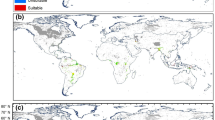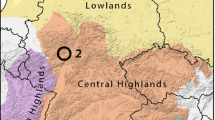Abstract
Spring ecosystems are exceptionally threatened and their conservation is often emphasized due to high levels of endemism among the groups inhabiting these ecosystems. This study includes gastropod assemblages of 36 springs situated in the northwestern part of Bosnia and Herzegovina. The aims of this paper were: to determine key factors for distribution of gastropod species on microspatial scale; to define the environmental preferences of gastropod species with respect to the physicochemical properties of water, the hydrological characteristics and the sediment structure; to determine species tolerance ranges and species optimums, with special emphasis on new and endemic species. Moreover the aim was to identify the species with highest extinction risk. The contribution of endangered and rare species to the total density was extremely high (64.6%). Species Response Curves were used to predict the distribution of gastropod species along the environmental gradient in the spring environments for the first time. The most important factors in structuring gastropod spring assemblages were oxygen and temperature. HOF (Huisman–Olff–Fresco) models may determine differences in range of environmental tolerance of species with similar ecological requirements. Our results have shown that two species: Ancylus fluviatilis and A. recurvus may be distinguished by their species response curves. Although there are no data on conservation status of A. recurvus, the extinction risk should be inferred as high, suggesting that IUCN status for this species should be updated to the category Vulnerable. Our study using HOF models revealed the potential gastropod species useful as indicators of karstic springs.



Similar content being viewed by others
References
Alonso A, Camargo JA (2003) Short-term toxicity of ammonia, nitrite, and nitrate to aquatic snail Potamopyrgus antipodarum (Hydrobiidae, Mollusca). Bull Environ Contam Toxicol 70:1006–1012
Balkovič J, Kollár J, Šimonovič V (2012) Experience with using Ellenberg’s Rindicator values in Slovakia: oligotrophic and mesotrophic submontanebroad-leaved forests. Biologia 67(3):474–482
Benavides JC, Vitt DH (2014) Response curves and the environmental limits for peat-forming species in the northern Andes. Plant Ecol 215:937–952
Bódis E, Tóth B, Sousa R (2016) Freshwater mollusk assemblages and habitat associations in the Danube River drainage, Hungary. Aquat Conserv 26:319–332
Bole J, Velkovrh F (1987) Nove vrste podzemeljskih polzev Jugoslavije (New Species of the subterranean Snails of Yugoslavia). SAZU 28(3):69–83
Cadotte MW, Carscadden K, Mirotchnick N (2011) Beyond species: functional diversity and the maintenance of ecological processes and services. J Appl Ecol 48:1079–1087
Dmitrović D, Savić A, Pešić V (2016) Discharge, substrate type and a temperature as a factors affecting the gastropod assemblages in springs in North-Western Bosnia and Herzegovina. Arch Biol Sci 68(3):613–621
Florescu D, Ioneto RE, Sandru C, Iordache A, Culea M (2011) The influence of pollution monitoring parameters in characterizing the surface water quality from Romanian southern areas. Rom J Phys 56(7–8):1001–1010
Fortunato H (2015) Mollusks: tools in environmental and climate research. Am Malacol Bull 33(2):1–15
Glöer P, Pešić V (2010) The freshwater snails of the gennus Bythinella Moquin-Tandon (Gastropoda: Rissooidea: Hydrobiidae) from Montenegro. Arch Biol Sci 62(2):441–447
Glöer P, Pešić V (2012) The freshwater snails (Gastropoda) of Iran, with descriptions of two new genera and eight new species. Zookeys 219:11–61
Glöer P, Pešić V (2014a) Belgrandiella bozidarcurcici n. sp., a new species from Bosnia and Hercegovina (Gastropoda: Hydrobiidae). Arch Biol Sci 66(2):461–464
Glöer P, Pešić V (2014b) Two new species of the genus Bythinella Moquin-Tandon, 1856 (Mollusca: Gastropoda: Hydrobiidae) from the Western Balkan Peninsula. Ecol Monten 1(4):249–255
Glöer P, Pešić V (2014c) New subterranean freshwater gastropod of Montenegro (Molusca: Gastropoda: Hydrobiidae), with description of one new genus and two new species. Ecol Monten 1(4):244–248
Hahn HJ (2000) Studies on classifying of undisturbed springs in Southwestern Germany by macrobenthic communities. Limnologica 30(3):247–259
Hoffsten PO, Malmqvist B (2000) The macroinvertebrate fauna and hydrogeology of springs in central Sweden. Hydrobiologia 436:91–104
Huisman J, Olff H, Fresco LFM (1993) A hierarchical set of models for species response analysis. J Veg Sci 4:37–46
Jansen F, Oksanen J (2013) How to model species responses along ecological gradients-Huisman-Olff-Fresco models revisited. J Veg Sci 24(6):1108–1117
Jenačković DD, Zlatković ID, Lakušić DV, Randjelović V (2016) Macrophytes as bioindicators of the physicochemical charactristic of wetlands and lowland and montain regions of the central Balkan Peninsula. Aquat Bot 134:1–9
Książkiewicz-Parulska Z, Ablett JD (2017) Microspatial distribution of molluscs and response of species to litter moisture, water levels and eutrophication in moist, alkaline ecosystems. Belg J Zool 147(1):37–53
Lawesson JE, Fosaa AM, Olsen E (2003) Calibration of Ellenberg indicator values for the Faroe Islands. Appl Veg Sci 6:53–62
Lydeard C, Cowie RH, Ponder WF, Bogan AE, Bouchet P, Clark SA, Cummings KS, Frest TJ, Gargominy O, Herbrt DG, Hershler R, Perez KE, Roth B, Seddon M, Strong EE, Thompson FG (2004) The global decline of nonmarine mollusks. Bioscience 54(4):321–330
Martinez MA, Thome DM (2006) Habitat usage by the Page springsnail, Pyrgulopsis morrisoni (Gastropoda: Hydrobiidae) from central Arizona. Veliger 48(1):8–16
Murria C, Bonada N, Prat N (2008) Effects of the invasive species Potamopyrgus antipodarum (Hydrobiidae, Mollusca) on community structure in a small Mediterranean stream. Fund Appl Limnol 171–172:131–143
Oksanen J, Minchin PR (2002) Continuum theory revisited: what shape are species responses along ecological gradients? Ecol Modell 157:119–129
Oyem HH, Oyem IM, Ezeweali D (2014) Temperature, pH, electrical conductivity, total dissolved solids and chemical oxygen demand of groundwater in Boji-BojiAgbor/Owa area and immediate suburbs. Res J Environ Sci 8:444–450
Pennak RW (1989) Fresh-water invertebrates of the United States: Protozoa to Mollusca. Wiley, New York
Pešić V, Glöer P (2013a) A new freshwater snail genus (Hydrobiidae, Gastropoda) from Montenegro, with a discussion on gastropod diversity and endemism in Skadar Lake. ZooKeys 281:69–90
Pešić V, Glöer P (2013b) Montenegrospeum, a new genus of Hydrobiid snails (Gastropoda: Risooidea) from Montenegro. Acta Zool Bull 64(4):565–566
Pešić V, Dmitrović D, Savić A, von Fumetti S (2016) Studies on eucrenal-hypocrenal zonation of springs along the river mainstream: a case study of a karst canyon in Bosnia and Hercegovina. Biologia 71(7):809–817
Pešić V, Gligorović B, Savić A, Buczynski P (2017) Ecological patterns of Odonata assemblages in karst springs in central Montenegro. Knowl Mang Aquat Ecosyst 418(3):20. https://doi.org/10.1051/kmae/2016035
Pešić V, Dmitrović D, Savić A et al (2019a) Application of macroinvertebrate multimetrics as a measure of the impact of anthropogenic modification of spring habitats. Aquat Conserv 2019:1–12
Pešić V, Savić A, Jablonska A, Michonski G, Grabowski M, Bankowska A, Zawal A (2019b) Environmental factors affecting water mite assemblages along eucrenon-hypocrenon gradients in Mediterranean karstic springs. Exp Appl Acarol. https://doi.org/10.1007/S10493-019-00360-w
Piechocki A, Wawrzyniak-Wydrowska B (2016) Guide to freshwater and marine Mollusca of Poland. Bogucki Wydawnictwo Naukowe, Poznań
Régnier C, Fonteine B, Bouchet P (2009) Not knowing, not recording, not listening: numerous unnoticed mollusk extinctions. Conserv Biol 23:1212–1221
Reiss H, Cunze S, König K, Neumann H, Kröncke I (2011) Species distribution modelling of marine benthos: a North Sea case study. Mar Ecol Prog Ser 442:71–86
Richards DC, Cazier LD, Lester GT (2001) Spatial distribution of three snail species, including the invader Potamopyrgus antipodarum, in a freshwater spring. West N Am Nat 61:375–380
Savić A, Dmitrovic D, Pešić V (2017) Ephemeroptera, Plecoptera and Trichoptera assemblages of karst springs in relation to some environmental factors: a case study in central Bosnia and Herzegovina. Turk J Zool 41:119–129
Seddon MB (2010) Islamia bosniaca. The IUCN Red List of Threatened Species 2010: e.T155763A4838848. https://doi.org/10.2305/iucn.uk.2010-4.rlts.t155763a4838848.en
Sket B, Seddon MB (2010) Marstoniopsis vrbasi. The IUCN Red List of Threatened Species 2010: e.T156040A4896969. https://doi.org/10.2305/iucn.uk.2010-4.rlts.t156040a4896969.en
Strong EE, Gargominy O, Ponder WF, Bouchet P (2008) Global diversity of gastropods (Gastropoda; Mollusca) in freshwater. Hydrobiologia 595:149–166
Tichý L (2002) JUICE, software for vegetation classification. J Veg 13(3):451–453
Uğurlu E, Oldeland J (2012) Species response curves of oak species along climatic gradients in Turkey. Int J Biometeorol 56(1):85–93
Von Fumetti S, Dmitrović D, Pešić V (2017) The influence of flooding and river connectivity on macroinvertebrate assemblages in rheocrene springs along a third-order river. Fund Appl Limnol 190(3):251–263
Wamelink GW, Goedhart PW, Van Dobben HF, Berendse F (2005) Plantspecies as predictors of soil pH: replacing expert judgment with measurements. J Veg Sci 16(4):461–470
Webb DW, Wetzel MJ, Reed PC, Philippe LR, Young TC (1998) The macroninvertebrate biodiversity, water quality, and hydrogeology of ten karst springs in the Salem Plateau of Illinois. In: Botosaneanu L (ed) Studies in Crenobiology: the biology of springs and springbrooks. Backhuys Publishers, Leiden, pp 39–48
Zawal A, Sulikowska-Drozd A, Stępień E, Jankowiak Ł, Szlauer-Łukaszewska A (2016a) Regeneration of the molluscan fauna of a small lowland river after dredging. Fund Appl Limnol 187:281–293
Zawal A, Lewin I, Stępień E, Szlauer-Łukaszewska A, Buczyńska E, Buczyński P, Stryjecki R (2016b) The influence of the landscape structure within buffer zones, catchment land use and instream environmental variables on mollusc communities in a medium-sized lowland river. Ecol Res 31:853–867
Zawal A, Stryjecki R, Stępień E, Buczyńska E, Buczyński P, Czachorowski S, Pakulnicka J, Śmietana P (2017) The influence of environmental factors on water mite assemblages (Acari, Hydrachnidia) in a small lowland river: an analysis at different levels of organization of the environment. Limnology 18:333–343
Author information
Authors and Affiliations
Corresponding author
Ethics declarations
Conflict of interest
The authors declare no conflict of interest.
Additional information
Communicated by David Hawksworth.
Publisher's Note
Springer Nature remains neutral with regard to jurisdictional claims in published maps and institutional affiliations.
Electronic supplementary material
Below is the link to the electronic supplementary material.
Rights and permissions
About this article
Cite this article
Savić, A., Dmitrović, D., Glöer, P. et al. Assessing environmental response of gastropod species in karst springs: what species response curves say us about niche characteristic and extinction risk?. Biodivers Conserv 29, 695–708 (2020). https://doi.org/10.1007/s10531-019-01905-6
Received:
Revised:
Accepted:
Published:
Issue Date:
DOI: https://doi.org/10.1007/s10531-019-01905-6




